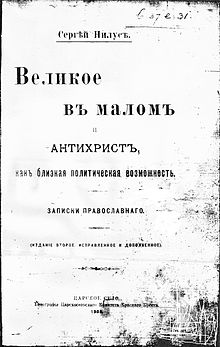The Protocols of the Elders of Zion

Cover of first book edition, The Great within the Minuscule and Antichrist
| |
| Author | Unknown. Plagiarised from Hermann Goedsche and Maurice Joly, plagiarized in turn from Eugène Sue and Alexandre Dumas, père |
|---|---|
| Original title | Програма завоевания мира евреями (Programa zavoevaniya mira evreyami, "The Jewish Programme to Conquer the World") |
| Country | Russian Empire |
| Language | Russian, with plagiarism from German and French texts |
| Subject | Antisemitic conspiracy theory |
| Genre | Propaganda |
| Publisher | Znamya |
Publication date
| August–September 1903 |
Published in English
| 1919 |
| Pages | 417 (1905 edition) |
The Protocols of the Elders of Zion (Russian: Протоколы сионских мудрецов) or The Protocols of the Meetings of the Learned Elders of Zion is an antisemitic fabricated text purporting to describe a Jewish plan for global domination. The hoax was first published in Russia in 1903, translated into multiple languages, and disseminated internationally in the early part of the 20th century. According to the claims made by some of its publishers, the Protocols are the minutes of a late 19th-century meeting where Jewish leaders discussed their goal of global Jewish hegemony by subverting the morals of Gentiles, and by controlling the press and the world's economies.
Henry Ford funded printing of 500,000 copies that were distributed throughout the United States in the 1920s. The Nazis sometimes used the Protocols as propaganda against Jews; it was assigned by some German teachers, as if factual, to be read by German schoolchildren after the Nazis came to power in 1933,[1] despite having been exposed as fraudulent by The Times of London in 1921. It is still widely available today in numerous languages, in print and on the Internet, and continues to be presented by some proponents as a genuine document.
No comments:
Post a Comment